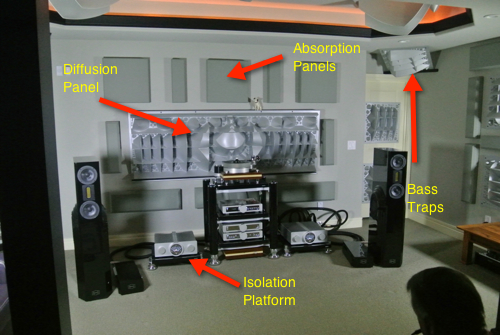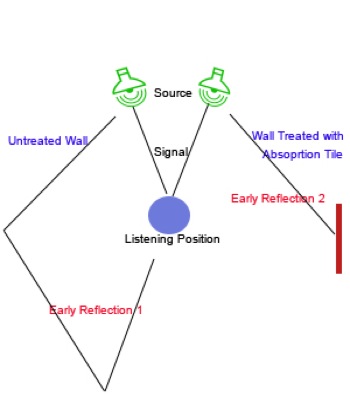In this article, we’re taking the beginner’s approach to room treatments with tips from seasoned audiophiles throughout.
By now, you’ve noticed that even the best equipment can sound horrible in a poorly designed space. Do you know how to retrofit your room to give it the best sound quality? Here are some things to think about:
- Do you plan on staying in your home for many years? If the answer is no, think about less-permanent, non-structural changes. Simple updates like, hanging a diffuser panel can help tremendously. It might be a sure-fire way to encourage your apartment manager to keep you security deposit!
- Determine a budget and stick to it.
- Figure out what you really need versus what you want.
- Let your ears be your guide. Just like equipment, it really only matters how something sounds to you.
- DIY projects are sometimes the simplest and most cost-effective way to treat your room. A little elbow grease and know-how can go a long way.
- Don’t be afraid to experiment. On paper, it might make sense to add an absorption panel, but it might not make sound sense after you’ve put a few area rugs down.
1. The Basics
Eliminate as many reflective surfaces as possible. Uncovered windows, family photo frames, hardwood floors, mirrors, etc can create a kind of echo chamber that will distort your stereo image as it bounces from one shiny surface to the next. Put some area rugs down on laminate floors, cover your desk with a tablecloth or mat, and move picture frames to another room. Those vintage bookshelves with glass doors may look cool, but they probably aren’t serving your high performance system very well.
Tip: Fashion drapery can be expensive, but for a fraction of the cost, you can get some blinds to do the job. Another option is searching the bathroom decor department at your local big box or department store. Decorative cloth shower curtains aren’t just sheer pink flowers anymore! They come in several lengths and widths, with designs ranging from elegant to funky, for a much more economical price. Remember to iron out any wrinkles prior to installation.
Organize and de-clutter your room. Sweep the dust bunnies out of the corners, detangle your wires, and make sure all your connections are clean. Studies have shown that humans focus better on the task at hand (i.e. active listening) when they’re in a space without a lot of “visual noise.” Distractions, like your kids’ toys or even your exposed work materials, can negatively impact the level of enjoyment you gain from your listening space.
Tip: Our friend, The Soundsmith, swears by using plastic lens cleaner diluted 50/50 with distilled water for cleaning CDs, DVDs, media discs, and other hard plastic surfaces. For terminals and connections, he recommends 91% isopropyl alcohol.
When it comes to cleaning solutions, be wary of snake oil salesmen.
2. Your Listening Position
Measure and think critically about your room. Sound needs space to develop, so avoid placing speakers and subs in an alcove or close to the walls. Correct room measurements will help you determine if you have slight dimension differences not apparent to your naked eye. Angled walls are generally easier to work with that parallel because they ensure that the sound waves move in an outward fashion instead of tunneling out.
Tip: Rear-ported components should always be set at least ten inches away because the lows won’t be reproduced correctly otherwise.
Locate your “sweet spot.” When sitting in your favorite listening chair, you should be able to visualize an imaginary triangle with your ears at the apex. Ideally, when in this position, you shouldn’t be able to distinguish tones between your right and left ears; it should sound as if the artist is right there in front of you playing live.
Tip: Keep your speakers angled toward your ears when you’re in the sitting position; make sure they don’t face out or up.
3. Acoustic Treatments

- Room utilizing several different types of acoustic treatment (pic courtesy of Aaudio Imports)
Absorption Tiles are the most common specialty treatment. If your room causes a lot of reflection, you might end up with an echo or ring, especially in the mids or highs, which can cause the dreaded listening fatigue. Usually sold as tiles, they can be made of fiberglass, recycled glass, woods like cork, polyfoam, etc. Varying densities will help tailor your sound. Manufacturers will generally have covering options to mesh with your style (though you can DIY this, too). The materials used are designed to absorb some or certain parts of the signal and prevent early reflections. It’s suggested that anyone new to absorption tiles go with broadband or higher density tiles because they work across a large frequency range.

- Early reflection treated with absorption panel
Tip: Too many absorption tiles can be a bad thing. Used smartly and sparingly, you can avoid turning your room into a dead space.
Diffuser Panels help keep the space open enough to create a natural sound while preventing delays common in reflection. Rather than the signal reflecting back to your ears all at once, a diffuser spreads it out at different intervals to keep the integrity of your stereo image. Constructed in small segments, diffuser panels are designed mathematically to generate the most faithful sound reproduction.
Tip: Diffuser Panels are great for small rooms where too much reflection is a constant issue.
Bass Traps prevent low-frequency energy from getting “stuck” in the corners of your room or at the angle of the joint between your ceiling and walls. For some listeners, this issue is highly intrusive in their space, but for others, it’s not as large a problem as reflection can be. If you feel your bass is too boomy and overpowering, start with trapping two corners in your room and go from there.
Tip: Wall-mounted bass traps can be very helpful in rooms where standing waves or nodes are a troublesome issue, but be careful because they can be on the pricey side.
Isolating your gear keeps you listening to the music, not your furniture’s resonance. Decoupling your speakers and subs by using dense platforms tends to be forgotten, but it’s pretty important. Just think of that car driving by with two 12-inch subwoofers in the trunk – all you can hear is the car shaking apart. When your components rest directly on your desk or bare tile floor, that what’s happening in your room on a smaller scale.
Tip: Isolation platforms also help prevent sound from traveling through your house. Something to consider if you like to listen at high volumes, have sleeping family members or cranky neighbors.
Suggested Reading:
- Sound Reproduction: The Acoustics and Psychoacoustics of Loudspeakers and Rooms, 2008 by Floyd Toole
- Master Handbook of Acoustics, 2009 by F. Alton Everest
Advice from Audiogon Members:
Tweakyman says: I just finished treating my room. I DIY’d it and worked experimentally and intuitively.
I started with “glare” high frequencies, early reflections. I built 5 1″ Fiberglas panels,(fabric covered with speaker cloth). That was a big improvement and encouraged the fabricating of 5 broadband absorbers mounted 3” away from the wall and Placed around the room (moved many times) until it cleared things up in the mid range and upper bass regions. That encouraged the need to address my old Nemesis, lot’s of confusion in deep bass, especially noticeable when driving my system with greater attenuation.
I constructed 2 air-tight 5″deep panels, Fiberglas damped and faced with 1/4″ resonating plywood sheet and one with 1/8th” ply to control sightly higher bass frequencies…
I also found it necessary to construct 4 dampers for the wall ceiling interface in areas where I could hear and feel that woolly bass rumble and excessive vibration. For these I used 12″ dia Fiberglas pipe wrap 1/2 sections with end caps and pegboard backing (Helmholtz)and of course full front and back fabric covering.
A lot of work to be sure, but the results are stunning.
I had pretty well tweaked myself out. I had addressed hundreds of little things over the many years but I never quite had the clarity of mind to attempt the (the final frontier) the room itself.
I can now drive the heck out my system without negative room interaction, I can hear every bass note clearly, and finally…. a piano sounds like a piano..to say nothing of a massive improvement in staging,specificity, depth, width etc
The research I carried out was all in the Audiogon forums.
I just kept reading stuff and making notes and piecing things together in my mind until I had a kind of map in my head, so I just did it.
Well worth the trouble. My system sounds exciting to me again. I would recommend putting thought and energy into room treatment to anybody.
From Edge22: Because of the physics of soundwaves and the dimensions of residential rooms, most rooms can benefit from room treatment, especially bass trapping. I had good sound before, but after getting some broad band asbortion panels that help even out the frequency spectrum the sound is now great, and I had no idea what I was missing.
KevinZoe states: Wall to wall carpet absorbs much more high frequencies than I first expected so to prevent a ‘dead sounding’ room, I focused on using diffusion rather than more absorption for mid/high frequencies which works like a charm. I also put a hard diffusive/reflective front face to many of my bass traps to again prevent further absorption of mid/high frequencies.
• Two parallel side walls introduced a very audible flutter echo which was eliminated with diffusion
• Walls with openings (e.g. doors, windows) extend the ‘acoustical length’ of the room dimension. For example, in my room placing bass trap absorption out from the front wall (which has a door that was shut) at the 25% point of 80Hz didn’t have the same impact as when the absorbers were moved to the back wall (with no door/windows) and placed at the exact same point.
• Experiment with the depth of the air space behind your resistive type bass traps. Real audible differences can be heard by pulling them out further and further from the corners.
So, Audiogon Members, what tips or tricks do you have for treating listening rooms? Sound off in the comments below!
